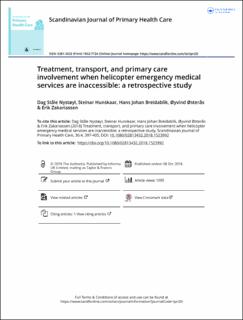| dc.contributor.author | Nystøyl, Dag Ståle | |
| dc.contributor.author | Hunskaar, Steinar | |
| dc.contributor.author | Breidablik, Hans Johan | |
| dc.contributor.author | Østerås, Øyvind | |
| dc.contributor.author | Zakariassen, Erik | |
| dc.date.accessioned | 2023-04-03T13:40:42Z | |
| dc.date.available | 2023-04-03T13:40:42Z | |
| dc.date.created | 2018-10-24T19:06:39Z | |
| dc.date.issued | 2018 | |
| dc.identifier.issn | 0281-3432 | |
| dc.identifier.uri | https://hdl.handle.net/11250/3061881 | |
| dc.description.abstract | Objective: To examine handling of cancelled helicopter emergency medical services (HEMS) missions with a persisting medical indication.
Design: Retrospective observational study.
Setting and subjects: Cancelled HEMS missions with persisting medical indication within Sogn og Fjordane county in Norway during the period of 2010–2013. Both primary and secondary missions were included.
Main outcome measures: Primary care involvement, treatment and cooperation within the prehospital system.
Results: Our analysis included 172 missions with 180 patients. Two-thirds of the patients (118/180) were from primary missions. In 95% (112/118) of primary missions, GPs were alerted, and they examined 62% (70/112) of these patients. Among the patients examined by a GP, 30% (21/70) were accompanied by a GP during transport to hospital. GP involvement did not differ according to time of day (p = 0.601), diagnostic group (p = 0.309), or patient’s age (p = 0.409). In 41% of primary missions, the patients received no treatment or oxygen only during transport. Among the secondary missions, 10% (6/62) of patients were intubated or received non-invasive ventilation and were accompanied by a physician or nurse anaesthetist during transport.
Conclusions: Ambulance workers and GPs have an important role when HEMS is unavailable. Our findings indicated good collaboration among the prehospital personnel. Many of the patients were provided minimal or no treatment, and treatment did not differ according to GP involvement. | en_US |
| dc.language.iso | eng | en_US |
| dc.rights | Navngivelse 4.0 Internasjonal | * |
| dc.rights.uri | http://creativecommons.org/licenses/by/4.0/deed.no | * |
| dc.title | Treatment, transport, and primary care involvement when helicopter emergency medical services are inaccessible: a retrospective study | en_US |
| dc.type | Journal article | en_US |
| dc.type | Peer reviewed | en_US |
| dc.description.version | publishedVersion | en_US |
| dc.rights.holder | Copyright 2018 The Author(s) | en_US |
| cristin.ispublished | true | |
| cristin.fulltext | original | |
| cristin.qualitycode | 1 | |
| dc.identifier.doi | 10.1080/02813432.2018.1523992 | |
| dc.identifier.cristin | 1623259 | |
| dc.source.journal | Scandinavian Journal of Primary Health Care | en_US |
| dc.source.pagenumber | 397-405 | en_US |
| dc.identifier.citation | Scandinavian Journal of Primary Health Care. 2018, 36 (4), 397-405. | en_US |
| dc.source.volume | 36 | en_US |
| dc.source.issue | 4 | en_US |

